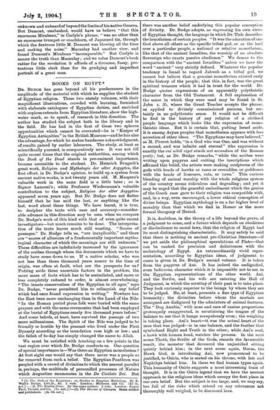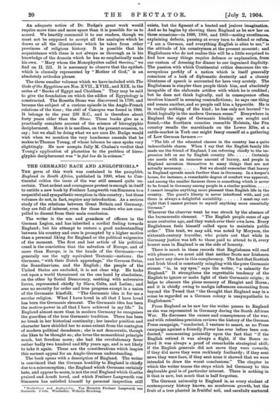BOOKS ON EGYPT.*
BuDGE has gone beyond all his predecessors in the amplitude of the material with which he supplies the student of Egyptian religion. These two stately volumes, with their magnificent illustrations, crowded with learning, furnished with elaborate catalogues of Egyptian deities, and enriched with copious extracts from Egyptian literature, show the high- water mark, so to speak, of research in this direction. The author has studied the subject both in the library and in the field. He has had in the first of these two spheres opportunities which cannot be overrated—he is "Keeper of Egyptian Antiquities" in the British Museum—and he has also the advantage, for which he makes handsome acknowledgment, of results gained by earlier labourers. The study, at least as scientifically pursued, is comparatively new. It was not till quite recent times that the original authorities, among which the Book of the Dead stands in pre-eminent importance, became accessible to the student. Dr. Heinrich Brugsch's great work, Religion und Mythologie der alter Aegypten, the first effort, in Dr. Budge's opinion, to build up a system from ancient native works, is not twenty years old. M. Maspero's valuable work in the same field is a little later ; so is Signor Lanzoni's ; while Professor Wiedermann's valuable contribution to the subject, Religion der alter Aegyptem appeared seven years ago. But Dr. Budge does not flatter himself that he has said the last, or anything like the last, word about these things. We have learnt, it is true, to decipher the texts with ease and accuracy—consider- able advance in this direction may be seen when we compare Dr. Budge's work of this kind with that of even quite recent investigators—but much remains to be done. The interpreta- tion of the texts leaves much still wanting. "Scores of passages," Dr. Budge tells us, "are inexplicable," and there are "scores of allusions of a fundamentally important mytho- logical character of which the meanings are still unknown." These difficulties are indefinitely increased by the ignorance of the scribes through whom the documents which we have to study have come down to us. If a native scholar, who was not less than three thousand years nearer to the time of origin, was often at fault, what are the prospects for us ? Putting aside these uncertain factors in the problem, the mere mass of facts which has to be assimilated, and more or less completely reduced to order, is almost overwhelming. "The innate conservatism of the Egyptian in all ages," says Dr. Budge, "never permitted him to relinquish any belief which had once found expression in writing." Nowhere has the East been more unchanging than in the Land of the Nile. " In the Roman period pious folk were buried with the same prayers and with the same ceremonies that had been employed at the burial of Egyptians nearly five thousand years before." And some beliefs, at least, have survived the passage of two more millenniums. The Spirit of the Nile was judged to be friendly or hostile by the peasant who lived under the First Dynasty according as the inundation rose high or low ; and the fellah of to-day has simply changed the name to Allah.
We must be satisfied with touching on a few points in the vast region over which Dr. Budge conducts us. One question of special importance is—Was there an Egyptian monotheism ? At first sight one would say that there never was a people so far removed from such a belief. The Egyptian Pantheon was peopled with a crowd of divinities to which the nearest parallel is, perhaps, the multitude of personified processes of Nature which Augustine enumerates in the De Civitate Dei. But * (1) The Gods of the Egyptians ; or, Studies in Egyptian Mythology. By B. WalIM Budge, Litt.D., Sc. 2 vols. London Methuen and Co. res 3s. net.] —(2) The Rosetta Stone. By the same author. 2 vols. London: Began Paid, Trench, and Co. r7s. net.]—(3) The Decrees of Canopus. Same author and publishers. 1.3a. 64. net.] there was another belief underlying this popular conception of divinity. Dr. Budge adopts, as expressing his own views of Egyptian thought, the language in which Dr. Tiele describes the henotheism of certain peoples. "It was the adoration of one God above all others as the specific tribal god, or as the lord over a particular people, a national or relative monotheism, like that of the ancient Israelites, the worship of an absolute Sovereign who exacts passive obedience." We demur to the comparison with the "ancient Israelites" unless we have the word " ancient " very strictly defined. Whatever the popular tendency in Israel to regard Jahweh as a tribal god, we cannot but believe that a genuine monotheism existed early in the history of the people; that this, in fact, was the great spiritual treasure which it had in trust for the world. Dr. Budge quotes expressions of an apparently polytheistic character from the Old Testament. A full explanation of the sense in which they were used may be found in St. John x. 35, where the Great Teacher accepts the phrase, as applied to divinely commissioned persons, but cer- tainly in no polytheistic sense. It would not be difficult to find in the history of any religion of a civilised people language which looks like the expression of mono- theistic ideas. But it is certain that, putting Israel aside, it is among Aryan peoples that monotheism appears with less accretion of other ideas. "The Egyptians may have believed," as M. Pierrot holds, "in a God who was One, and was without a second, and was infinite and eternal" (the expression is exactly the cui nihil viget simile aut secundum of the Roman poet) ; but, as Dr. Budge remarks, "while the scribes were writing upon papyrus and cutting the inscriptions which affirmed this belief, the artists were making sculptures of the gods with heads of hawks or rams or crocodiles, or goddesses with the heads of lionesses, cats, or cows." This curious blending of animal worship with the whole religious system of the country seems ridiculous and degrading ; and yet it may be urged that the graceful embodiment which the genius of the Greek race gave to their religion was compatible with, and, in a way, even encouraged, a lower ethical conception of divine beings. Egyptian mythology is on a far higher level of morality than that which we find in Homer or the more formal theogony of Hesiod.
It is, doubtless, in the theory of a life beyond the grave, of a judgment to come, and a future which depends on obedience or disobedience to moral laws, that the religion of Egypt had its most distinguishing characteristic. It may safely be said that there is nothing in ancient pre-Christian literature—if we put aside the philosophical speculations of Plato—that can be ranked for precision and definiteness with the eschatology of Egypt. An extraordinarily vivid repre- sentation, according to Egyptian ideas, of judgment to come is given in Dr. Budge's second volume. It is taken from the papyrus of Ani. It has indeed the undignified, even ludicrous, character which it is impossible not to see in the Egyptian representations of the other world. Ani, and the Scribe, and his wife are entering the Hall of Judgment, in which the scrutiny of their past is to take place. They look curiously superior to the beings by whom they are to be judged. He, at least, presents a fine type of Egyptian humanity ; the divinities before whom the mortals are arraigned are disfigured by the admixture of animal features. The "Dog Anubis," with nose and ears of canine proportions grotesquely exaggerated, is scrutinising the tongue of the balance to see that it hangs scrupulously even ; the weighing is taking place. Anis heart—it was the actual heart of the man that was judged—is in one balance, and the feather that symbolised Right and Truth in the other; while Ani's soul, a hawk with human bead, watches the process. In the next scene Thoth, the Scribe of the Gods, records the favourable result, the monster that devoured the unjustified sitting quietly behind him; in the next scene again, Horns, the Hawk God, is introducing Ani, now pronounced to be justified, to Osiris, who is seated on his throne, with Isis and Nephthys behind him. In these we find human types again. This humanity of Osiris suggests a most interesting train of thought. It is in the Osiris legend that we have the nearest approach to the religious ideas which occupy the first place in our own belief. But the subject is too large, and, we may say, too full of the risks which attend on any utterances not thoroughly well weighed, to be discussed here.
An adequate notice of Dr. Badge's great work would require more time and more space than it is possible for us to accord. We heartily commend it to our readers, though we must not be supposed to accept all the analogies which he draws or all the illustrations which he takes from other provinces of religious history. It is possible that his acquaintance with these is not always as thorough as is his knowledge of the domain which he has so emphatically made his own. "Mary whom the Monophysites called efor‘soc," we find on II. 221. It is necessary to observe that the epithet, which is clumsily represented by "Mother of God," is an absolutely orthodox phrase.
The three smaller volumes which we have included with The Gods of the Egyptians are Nos. XVII., XVIII., and XIX. in the series of "Books of Egypt and Chaldaea." They may be said to give the foundation on which the edifice of Egyptology is constructed. The Rosetta Stone was discovered in 1799, and became the subject of a curious episode in the Anglo-French relations of the time ; the stele of Canopus was found in 1866. It belongs to the year 238 B.C., and is therefore about forty years older than the Stone. These books give us a practically complete account of the science of hieroglyphic decipherment. More it is needless, on the present occasion, to say ; but we shall be doing what we are sure Dr. Budge would wish when we mention the very handsome amends that he makes to Thomas Young, of whose labours he once spoke very slightingly. He now accepts fully M. Chabas's verdict that Young's application of phonetics to the problem of hiero- glyphic decipherment was "le fiat lux de la science."















































 Previous page
Previous page